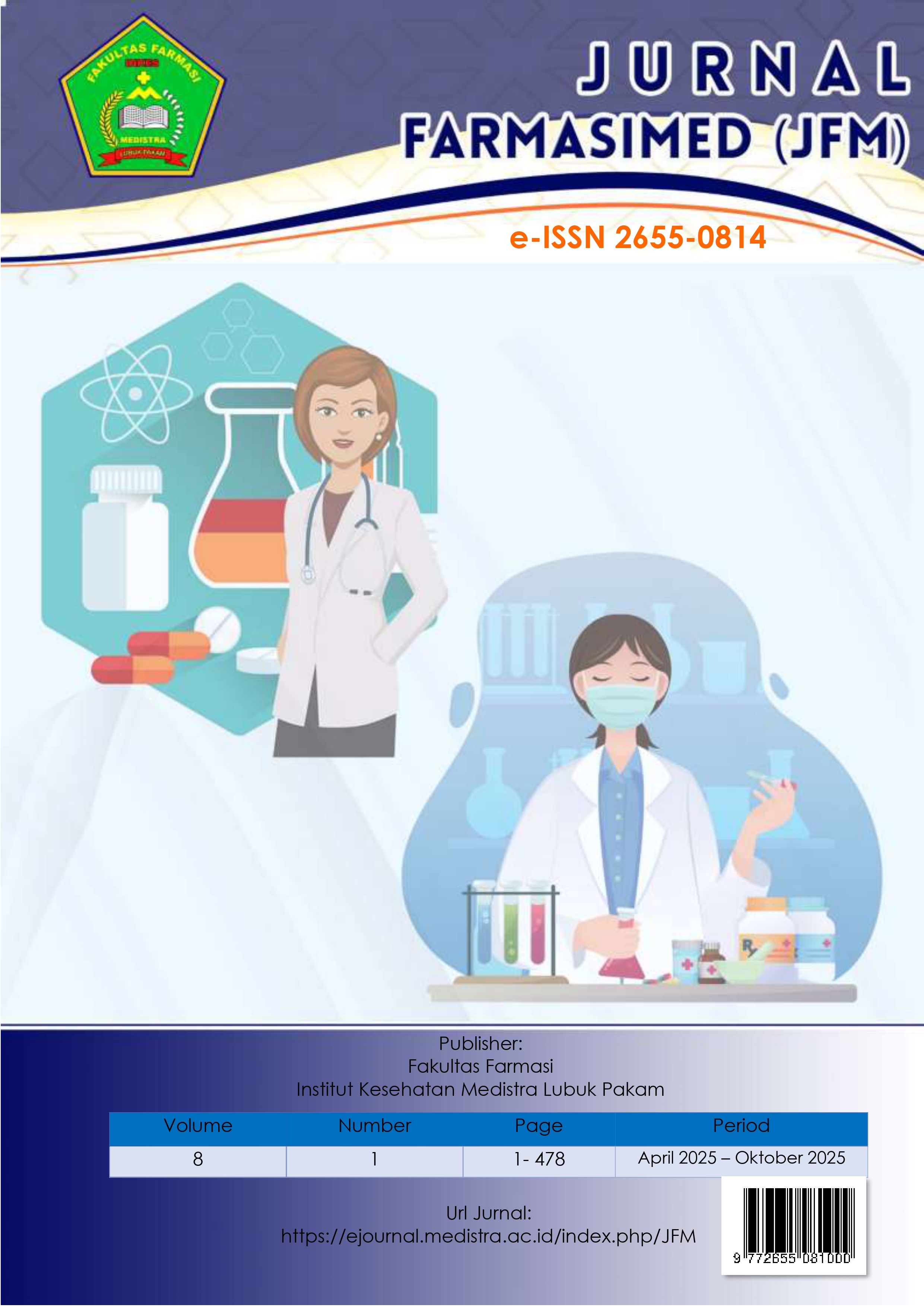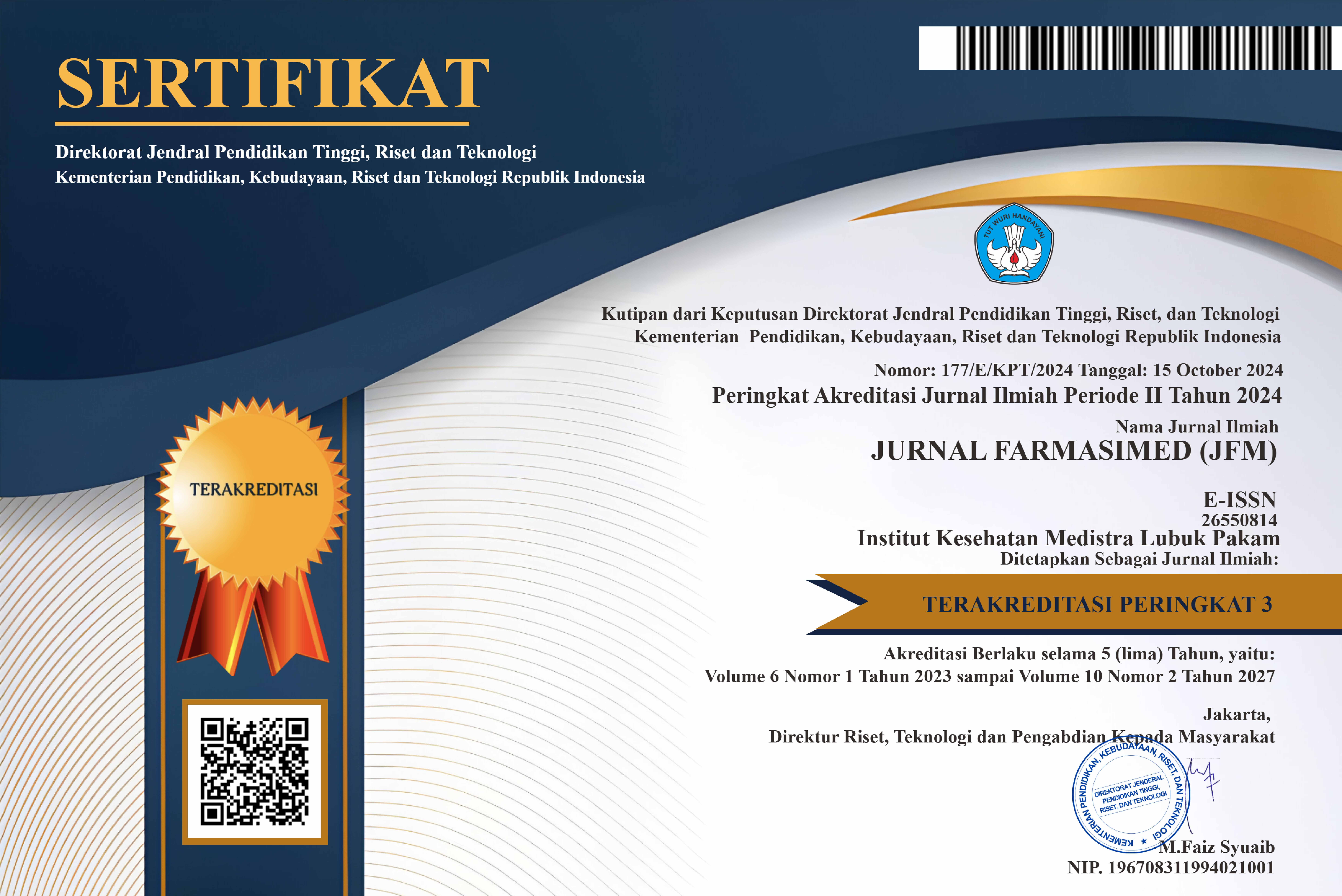Formulation of Facial Wash Gel from Kalamansi Orange (Citrusn microcarpa) Peel Extract as an Antioxidant for Facial Skin Care
DOI:
https://doi.org/10.35451/cf4ejv16Keywords:
Facial wash gel, Kalamansi bark extract, Evaluation of physical properties, Antioxidant activity, DPPH methodAbstract
Cosmetics are preparations used on the outer layer of the human body to cleanse, perfume, beautify, and maintain the body in good condition. Free radicals are reactive oxygen species with unpaired electrons that are unstable and can cause cellular damage, leading to degenerative diseases. Antioxidants play an important role in preventing this damage by inhibiting oxidation processes and scavenging free radicals. This study aimed to develop a facial soap gel formulation using calamansi orange peel extract (Citrus microcarpa) as the active ingredient. The extract was obtained through maceration using 96% ethanol and concentrated with a rotary evaporator. The facial soap gel was formulated in three concentrations, namely 1%, 1.5%, and 2%, and its physical properties were evaluated through organoleptic, pH, homogeneity, foaming power, viscosity, spreadability, and hedonic tests. The findings indicate that the calamansi orange peel extract was successfully formulated into a facial soap gel that meets the physical evaluation requirements. Antioxidant activity testing using the DPPH method shows that Formula III exhibits the highest antioxidant activity with an inhibition percentage of 73.75% and an IC₅₀ value of 29.45 µg/mL. Formula III has the potential to be developed as a functional facial soap that not only cleanses but also provides protection against skin damage caused by free radicals.
Downloads
References
[1] BPOM RI, “Peraturan Badan Pengawas Obat dan Makanan No 18 Tahun 2024 tentang Peandaan, Promosi dan Iklan Kosmetik,” PerBPOM, no. 18, pp. 1–23, 2024.
[2] M. Purwanto, E. S. Yulianti, I. N. Nurfauzi, and W. Winarni, “KARAKTERISTIK DAN AKTIVITAS ANTIOKSIDAN SABUN PADAT DENGAN PENAMBAHAN EKSTRAK KULIT BUAH NAGA (Hylocereus polyrizhus),” Indones. Chem. Appl. J., vol. 3, no. 1, p. 14, 2019, doi: 10.26740/icaj.v3n1.p14-23.
[3] H. Hidayah, S. Amal, A. K. Sundara, and D. Nurfadilah, “Pengembangan Sediaan Kosmetik dari Bahan Alam Formulasi Serum dan Facial Wash Dari Daun Jamblang (Syzygium cumini (L) Skeels),” Eureka Media Aksara, pp. 1–82, 2022.
[4] UNTARI, “KAJIAN KANDUNGAN KIMIA SERTA AKTIVITAS ANTIOKSIDAN DAN ANTIBAKTERI TANAMAN JERUK MANDARIN (Citrus reticulata Blanco),” Kaji. Kandung. Kim. SERTA Akt. ANTIOKSIDAN DAN ANTIBAKTERI Tanam. JERUK MANDARIN (Citrus Reticul. Blanco)progr. Stud. Farm. Fak. Farm. DAN SAINS Univ. MUHAMMADIYAH PROF. DR. HAMKA JAKARTA 2021, 2021.
[5] G. Mulyani Wulandari, Nora Idiawati, “Antioksidan Ekstrak n - Heksana, Etil Asetat Dan Metanol Kulit Buah Jeruk Sambal (Citrus microcarpa Bunge),” Jkk. Accessed: Jul. 28, 2025. [Online]. Available: https://jurnal.untan.ac.id/index.php/jkkmipa/article/view/3899
[6] R. S. D. Andini Dianatasya, Farach Khanifa, “ANALISA KADAR VITAMIN C INFUSED WATER BUNGA TELANG (Clitoria ternatea) DAN LEMON (Citrus limon),” Etika Jurnalisme Pada Koran Kuning Sebuah Stud. Mengenai Koran Lampu Hijau, vol. 16, no. 2, pp. 39–55, 2015.
[7] L. N. Muna, Emelda, and D. N. Hidayati, “Formulasi dan Uji Sifat Fisik Sediaan Gel Ekstrak Etanol Kulit Lemon Berbasis Karbomer 940,” LUMBUNG Farm. ; J. Ilmu Kefarmasian, vol. 4, no. 1, p. 94, 2023.
[8] Y. Arsimida and D. Dominica, “Formulasi Lip Cream Ekstrak Kulit Jeruk Kalamansi (Citrofortunella Microcarpa L.) Sebagai Pelembap dan Sari Umbi Bit (Beta Vulgaris L.) sebagai Pewarna Alami,” J. Farm. IKIFA, vol. 3, no. 2, pp. 43–55, 2024.
[9] S. Amin, D. Pebriyanti, S. Qolbiah, and S. N. Candramurti, “Analisis Fitokimia Dan Penetapan Kadar Flavonoid Total Pada Ekstrak Daun Matoa (Pometia pinnata) Dengan Metode Spektrofometri UV-Vis,” J. Innov. Creat., vol. 5, no. 2, pp. 246–254, 2025, doi: 10.31004/joecy.v5i2.164.
[10] T. A. Putra, K. A. Safitri, Z. A. N. Bisam, and T. A. Shinta, “Identifikasi Senyawa Metabolit Sekunder Ekstrak Etanolik Kulit Umbi bit (Beta vulgaris L.),” J. Ilm. Bakti Farm., vol. 7, no. 2, pp. 5–9, 2023, doi: 10.61685/jibf.v7i2.93.
[11] W. F. Dewatisari, L. Rumiyanti, and I. Rakhmawati, “Rendemen dan Skrining Fitokimia pada Ekstrak Daun Sanseviera sp.,” J. Penelit. Pertan. Terap., vol. 17, no. 3, p. 197, 2018, doi: 10.25181/jppt.v17i3.336.
[12] E. Widayanti, J. Mar’ah Qonita, R. Ikayanti, and N. Sabila, “Pengaruh Metode Pengeringan terhadap Kadar Flavonoid Total pada Daun Jinten (Coleus amboinicus Lour),” Indones. J. Pharm. Educ., vol. 3, no. 2, pp. 219–225, 2023, doi: 10.37311/ijpe.v3i2.19787.
[13] E. M. R. Yusril Mokodompit,Herny E. L. Simbala, “DETERMINATION NON-SPESIFIK STANDARIZATION OF FOREST ONION BULBS EXTRACT (ELEUTHERINE AMERICANA MERR),” vol. 8, no. 2, pp. 57–63, 2023.
[14] S. Koralina, E. S. Sunarsih, and F. Wulandari, “Uji Aktivitas Sediaan Hair Tonic Ekstrak Etanol 70% Daun Pare (Momordica charantia L.) Terhadap Pertumbuhan Rambut Pada Kelinci (Oryctolagus cuniculus),” Orig. Artic. MFF, vol. 27, no. 3, pp. 103–109, 2023, doi: 10.20956/mff.v27i3.27548.
[15] R. M. Paendong, Fatmawati, and J. S. Lebang, “CHARACTERIZATION OF ETHANOL EXTRACT OF SUANGGI LEMON PEEL (Citrus limon L.) KARAKTERISASI EKSTRAK ETANOL KULIT BUAH LEMON SUANGGI (Citrus limon L.),” Pharcon, vol. 11, no. 1, pp. 1302–1308, 2022.
[16] Evi Marlina, Naelaz Zukhruf Wakhidatul Kiromah, and Titi Pudji Rahayu, “FORMULASI SEDIAAN ANTIOKSIDAN FACIAL WASH EKSTRAK METANOL DAUN GANITRI (Elaeocarpus ganitrus Roxb.) DENGAN VARIASI SODIUM LAURIL SULFAT SEBAGAI SURFAKTAN,” J. Ilm. Manuntung Sains Farm. Dan Kesehat., vol. 8, no. 1, pp. 181–190, 2022, doi: 10.51352/jim.v8i1.599.
[17] O. R. Wulandari and N. Ermawati, “FORMULASI DAN EVALUASI SIFAT FISIK SEDIAAN FACIAL WASH GEL EKSTRAK BUAH TOMAT (Solanum lycopersicum L.) DENGAN VARIASI CARBOPOL SEBAGAI GELLING AGENT,” J. Pharmacopoeia, vol. 3, no. 1, pp. 1–11, 2024, doi: 10.33088/jp.v3i1.572.
[18] S. R. Nur Endah, C. Shintia, and A. Nofriyaldi, “Stability Test of Gel Hand Sanitizer Ethanol Extract of Nutmeg (Pala) Leaves (Myristica fragrans Houtt.) with Variation of the Concentration of HPMC (Hydroxy Propyl Methyl Cellulose) and Glycerine,” J. Food Pharm. Sci., vol. 9, no. 1, pp. 395–402, 2021, doi: 10.22146/jfps.1150.
[19] Rizgy Anggia, S. Adlina, and Nitya Nurul Fadilah, “Anggia et al.; Uji Efektivitas Sediaan Facial Wash … Perjuangan Nature Pharmaceutical Conference Volume 1 No. 1, Januari 2024,” vol. 1, no. 1, pp. 178–190, 2024.
[20] D. Rusli, K. Amelia, and S. Gading Setia Sari, “Formulasi dan Evaluasi Sediaan Gel Ekstrak Daun Kelor (Moringa Oleifera Lam.) Dengan Variasi NaCMC Sebagai Basis,” J. Ilm. Bakti Farm., vol. 6, no. 1, pp. 7–12, 2023, doi: 10.61685/jibf.v6i1.72.
[21] H. R. Dwi, “Formulasi dan uji sifat fisik sediaan gel facial wash dari ekstrak lobak (Raphanus sativus L) dan bengkuang (Pachyrizus erosus),” E-Journal PoltekkesTegal, pp. 1–9, 2020.
[22] Klaudia BR Semimbing, “FORMULASI DAN UJI HEDONIK SABUN MANDI PADAT AROMATERAPI DAUN JERUK PURUT (Citrus hystrix DC.) DAN SERAI WANGI (Cymbopogon winterianus Jowitt.),” p. 6, 2021.
[23] R. W. Ramadeni, S. Malahayati, and D. Mahdiyah, “Formulasi dan Evaluasi Sediaan Facial Wash Gel Ekstrak Daun Kersen (Muntingia calabura L) Sebagai Antioksidan,” Sains Med., vol. 1, no. 5, pp. 259–266, 2023.
[24] N. Azizah, N. Aliza Putriana, and T. Daru Asmara Tugon, “Formulasi Dan Evaluasi Sediaan Toner Dari Ekstrak Biji Hanjeli (Coix Lacryma-Jobi L.) Sebagai Antioksidan,” Maj. Farmasetika, vol. 9, no. 6, pp. 577–595, 2024, doi: 10.24198/mfarmasetika.v9i6.59038.
[25] H. Herlina, D. Paramita, Pitriani, and L. Sirumapea, “PENGEMBANGAN LOTION TUBUH DARU EKSTRAK ETANOL TEMULAWAK (CURCUMA xanthoriza roxb) Sebagai Antioksidan,” J. Farm., vol. 6, no. 2, pp. 163–172, 2024.
[26] V. E. Kaban and S. Yusmarlisa, “Uji Aktivitas Kandungan Antioksidan pada Daun Bangun-bangun (Plectranthus amboinicus) Secara Spektrofotometri Ultraviolet-Visible,” J. Farm., vol. 1, no. 1, pp. 16–20, 2018.
Downloads
Published
Issue
Section
License
Copyright (c) 2025 Liany Carolina Rambu Lika, Liany Carolina Rambu Lika

This work is licensed under a Creative Commons Attribution-NoDerivatives 4.0 International License.
Copyright in each article is the property of the Author.

























